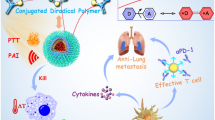Abstract
Chlorin derivatives are promising photosensitive agents for photodynamic therapy (PDT) of tumors. The aim of the current study is to investigate the PDT therapeutic effects of a novel chlorin-based photosensitizer, meso-tetra[3-(N,N-diethyl)aminomethyl-4-methoxy]phenyl chlorin (TMPC) for gliomas in vitro and in vivo. Physicochemical characteristics of TMPC were recorded by ultraviolet visible spectrophotometer and fluorescence spectrometer. The rate of singlet oxygen generation of TMPC upon photo-excitation was detected by using 1,3-diphenylisobenzofuran (DPBF). The accumulation of TMPC in gliomas U87 MG cells was measured by fluorescence spectrometer. The efficiency of TMPC-PDT in vitro was analyzed by MTT assay and clonogenic assay. The biodistribution and clearance of TMPC were determined by fluorescence measuring. Human gliomas U87 MG tumor-bearing mice model was used to evaluate the antitumor effects of TMPC-PDT. TMPC shows a singlet oxygen generation rate of 0.05 and displays a characteristic long wavelength absorption peak at 653 nm (ε = 15,400). The accumulation of TMPC increased with the increase of incubation time. In vitro, PDT using TMPC and laser showed laser dose- and concentration-dependent cytotoxicity to U87 MG cells. In U87 MG tumor-bearing mice, TMPC-PDT significantly reduced the growth of the tumors. Both in vitro and in vivo, TMPC showed little dark toxicity. In vitro and in vivo studies, it found that TMPC has excellent antitumor activities. It suggests that TMPC is a potential photosensitizer of photodynamic therapy for cancer.






Similar content being viewed by others
References
Omuro A, DeAngelis LM. Glioblastoma and other malignant gliomas: a clinical review. JAMA. 2013;310:1842–50.
Dougherty TJ, Gomer CJ, Henderson BW, Jori G, Kessel D, Korbelik M, et al. Photodynamic therapy. J Natl Cancer Inst. 1998;90:889–905.
Kennedy JC, Pottier RH, Pross DC. Photodynamic therapy with endogenous protoporphyrin IX: basic principles and present clinical experience. J Photochem Photobiol B. 1990;6:143–8.
Castano AP, Mroz P, Hamblin MR. Photodynamic therapy and anti-tumour immunity. Nat Rev Cancer. 2006;6:535–45.
Dolmans DE, Fukumura D, Jain RK. Photodynamic therapy for cancer. Nat Rev Cancer. 2003;3:380–7.
Wong TW, Aizawa K, Sheyhedin I, Wushur C, Kato H. Pilot study of topical delivery of mono-l-aspartyl chlorin e6 (npe6): implication of topical npe6-photodynamic therapy. J Pharmacol Sci. 2003;93:136–42.
Laville I, Figueiredo T, Loock B, Pigaglio S, Maillard P, Grierson DS, et al. Synthesis, cellular internalization and photodynamic activity of glucoconjugated derivatives of tri and tetra(meta-hydroxyphenyl)chlorins. Bioorg Med Chem. 2003;11:1643–52.
Redmond RW, Gamlin JN. A compilation of singlet oxygen yields from biologically relevant molecules. Photochem Photobiol. 1999;70:391–475.
Houle JM, Strong A. Clinical pharmacokinetics of verteporfin. J Clin Pharmacol. 2002;42:547–57.
Mosmann T. Rapid colorimetric assay for cellular growth and survival: application to proliferation and cytotoxicity assays. J Immunol Methods. 1983;65:55–63.
Zhao H, Yin R, Chen D, Ren J, Wang Y, Zhanga J, et al. In vitro and in vivo antitumor activity of a novel hypocrellin b derivative for photodynamic therapy. Photodiagn Photodyn Ther. 2014;11:204–12.
Tang W, Xu H, Kopelman R, Philbert MA. Photodynamic characterization and in vitro application of methylene blue-containing nanoparticle platforms. Photochem Photobiol. 2005;81:242–9.
Dougherty TJ. Photodynamic therapy: part II. Semin Surg Oncol. 1995;11:333–4.
Huang Z. A review of progress in clinical photodynamic therapy. Technol Cancer Res Treat. 2005;4:283–93.
Ashen-Garry D, Selke M. Singlet oxygen generation by cyclometalated complexes and applications. Photochem Photobiol. 2014;90:257–74.
Silva EF, Serpa C, Dabrowski JM, Monteiro CJ, Formosinho SJ, Stochel G, et al. Mechanisms of singlet-oxygen and superoxide-ion generation by porphyrins and bacteriochlorins and their implications in photodynamic therapy. Chemistry. 2010;16:9273–86.
Juzeniene A, Peng Q, Moan J. Milestones in the development of photodynamic therapy and fluorescence diagnosis. Photochem Photobiol Sci: Off J Eur Photochem Assoc Eur Soc Photobiol. 2007;6:1234–45.
Oleinick NL, Morris RL, Belichenko I. The role of apoptosis in response to photodynamic therapy: what, where, why, and how. Photochem Photobiol Sci: Off J Eur Photochem Assoc Eur Soc Photobiol. 2002;1:1–21.
Krammer B. Vascular effects of photodynamic therapy. Anticancer Res. 2001;21:4271–7.
Dolmans DE, Kadambi A, Hill JS, Waters CA, Robinson BC, Walker JP, et al. Vascular accumulation of a novel photosensitizer, mv6401, causes selective thrombosis in tumor vessels after photodynamic therapy. Cancer Res. 2002;62:2151–6.
Korbelik M. Induction of tumor immunity by photodynamic therapy. J Clin Laser Med Surg. 1996;14:329–34.
Canti G, De Simone A, Korbelik M. Photodynamic therapy and the immune system in experimental oncology. Photochem Photobiol Sci: Off J Eur Photochem Assoc Eur Soc Photobiol. 2002;1:79–80.
Acknowledgments
This work was supported by the Chinese National Natural Science Foundation (No. 21372042, 21402236, 81101298, 81301878), Foundation of Shanghai Government (No. 14431906200, 14140903500, 13431900700, 13430722300, 13ZR1441000, 13ZR1440900, 14ZR1439800, 14ZR1439900, 15ZR1439900, 15XD1523400, 14SJGGYY08, 201370), International Cooperation Foundation of China and Croatia (6-11), and Foundation of Yiwu Science and Technology Bureau (No. 2012-G3-02, 2013-G3-03).
Conflicts of interest
None
Author information
Authors and Affiliations
Corresponding author
Rights and permissions
About this article
Cite this article
Wang, LX., Li, JW., Huang, JY. et al. Antitumor activity of photodynamic therapy with a chlorin derivative in vitro and in vivo. Tumor Biol. 36, 6839–6847 (2015). https://doi.org/10.1007/s13277-015-3395-1
Received:
Accepted:
Published:
Issue Date:
DOI: https://doi.org/10.1007/s13277-015-3395-1




